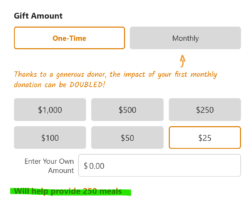One Panda Or Four?
Researchers asked separate groups of people how much they’d donate to save 2,000, 20,000 or 200,000 migrating birds drowning in an oil pond. The mean responses are stunningly similar, $80, $78 and $88. This underscores what is wonkily called “scope neglect” or the inability or unwillingness to factor in the size of the problem as part of the giving decision.
Why does this happen? There is a certain logic to my donating $1 to save 2,000 birds and $100 to save 100 times more birds, 200,000. However, giving rarely plays out that way. Instead, we tend to focus on an image in the solicitation or pre-existing from our mental library. In the bird example no images were shown but post-experiment, survey research affirmed most people were thinking about the nearly iconic, generalized image of a bird covered in oil. Your brain probably just pulled that image up for you automatically after reading that last sentence.
This image makes our decision on how much to give more emotive and affective, rendering us scope insensitive.
Another experiment manipulated the image shown ( pic of real panda or dot to represent a panda) and the number of pandas helped (1 or 4). This was a 2×2 experiment yielding four conditions:
- Four dots to help the four pandas needing rescue
- Four panda pics to help the four pandas needing rescue
- One dot to help the one panda needing rescue
- One panda pic to help the one panda
The ask string was the same, $10, $20, $30 or $40 and it was visually presented to imply a linear relationship between money and pandas, $10 = helping 1, $20, 2 etc.
One dot loses to one panda pic, average gift was $11.67 vs. $19.49 respectively. But, four dots beat four panda pics, $22 vs. $18.95.
The picture makes me unlikely to think about the size or scope of the problem. I’m helping the panda, whether you show me one or four. The dots don’t invoke the same affective lens. I’m more calculative, more numeric in my thinking and give more to help the extra pandas in need.
We Need to Pay More Attention to Response Forms
What to do with this? I’d argue ask string optimization and all the context that goes with it (e.g., appeal, the reply form) is ripe for more rigorous study and a new set of best practices.
This research argues for trying to create a less affective, more calculative mindset on the (online or paper) reply form. Use the imagery to drive the give/not give decision and more rationale, less emotive framing on the giving page.
For starters, test losing the image and references to pandas or meals or other subjective, qualitative ways to think about the donation amount. Instead, try priming the calculative mindset by pointing out the math – e.g., you can deliver three times as many meals for $60 as $20.
Many groups have this symmetry and do the basic math  for each gift amount like this Feeding America form whose value (in green that we highlighted) dynamically changes as you select different amounts.
for each gift amount like this Feeding America form whose value (in green that we highlighted) dynamically changes as you select different amounts.
But, what about making the callout comparative to reinforce the linear nature of the give/value curve? For instance, the $50 message would show that you can do 250 more meals or twice as much as the $25.
This is but one idea among a cast of thousands. As always, our limitation isn’t ideas but a rigorous way to prioritize what to test, how and with the aim of generalizability that only comes from theory as the guiding light and test design that tells us why something happened, not just that it did.
Kevin



hi, one great free research library on online ask string (and much more) testing can be found here..https://www.nextafter.com/research/
of course, every organization is different so you’d still need to test things for your organization but those are just helpful experiments to look at…